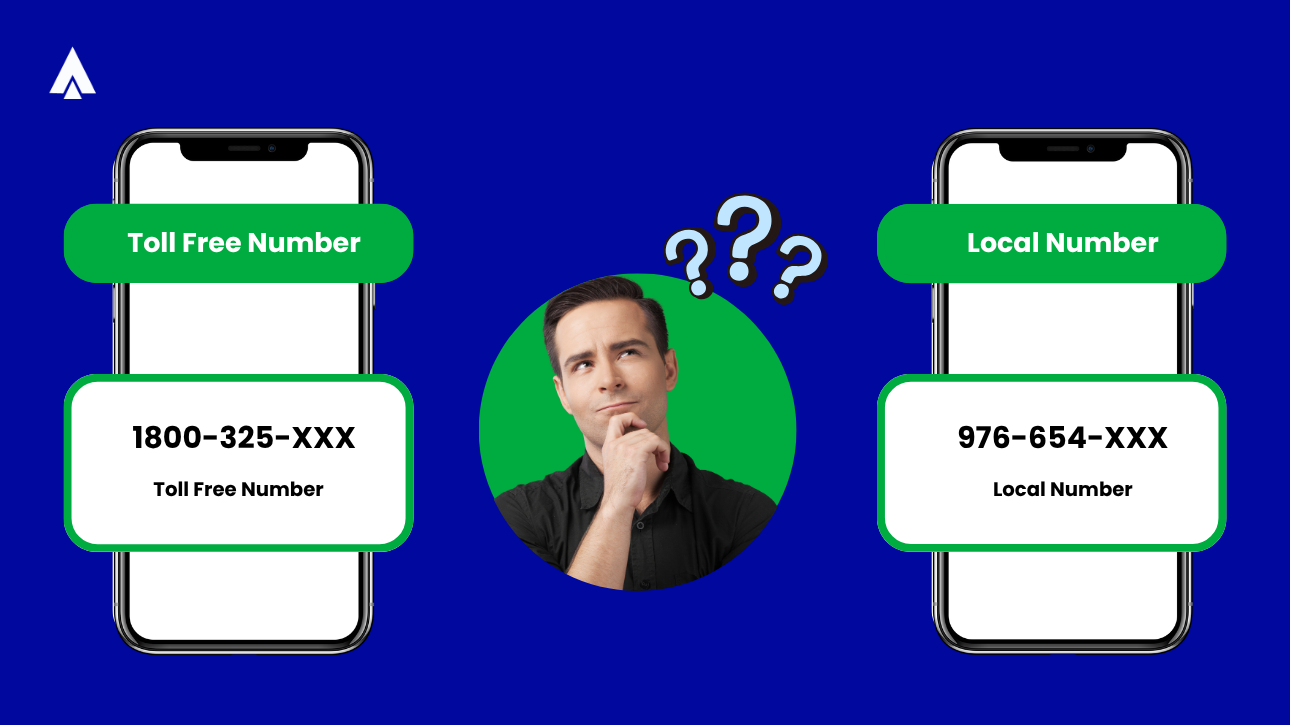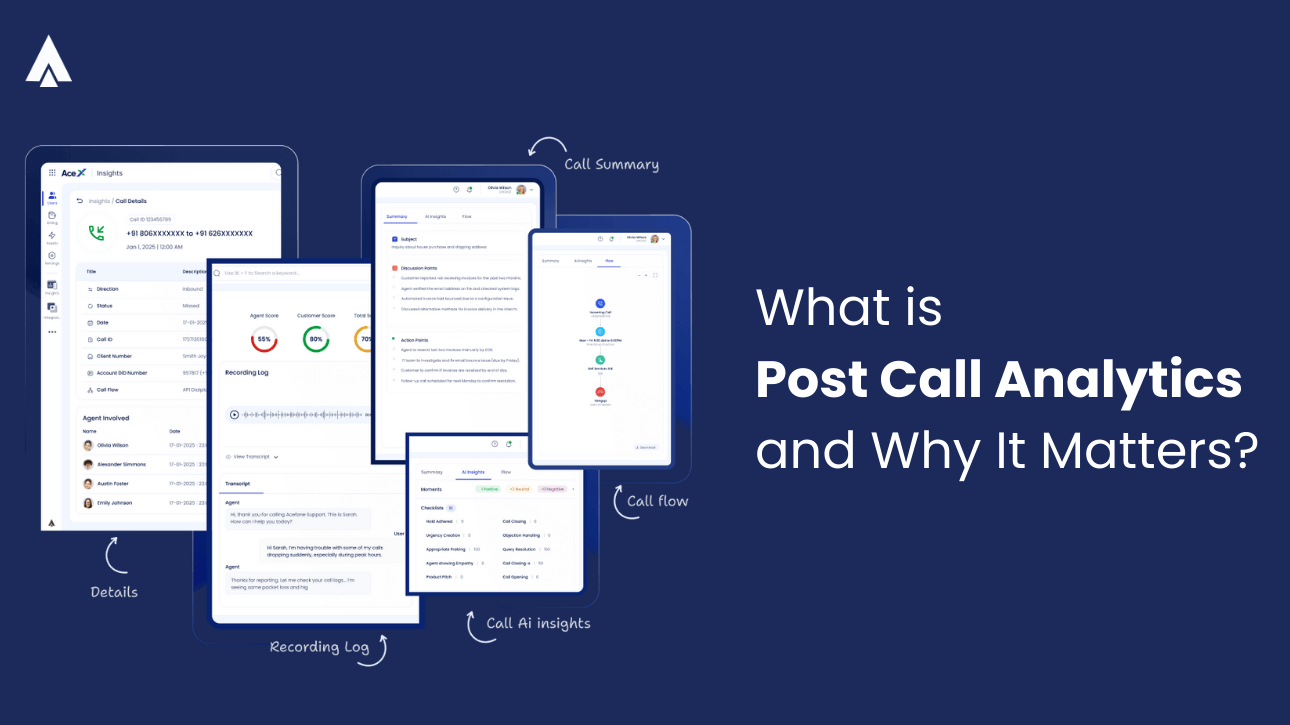Here’s a reality most business owners face: You think you have your finger on the pulse when it comes to customer delight. But when customers try reaching you, they hesitate. The long-distance charges make them think twice. Or worse, your local number makes you look too small to handle their needs.
And if you think that chatbots can be a sufficient replacement for calls, you are in for a surprise. According to a recent McKinsey study, 57% of customer-facing leaders expect call volumes to reach to increase by one-fifth over the next couple of years. So, your calls are not going anywhere. It is high time you make sure that all the components of your calling system work efficiently, especially numbers.
Your phone number choice isn’t just a technical decision. It’s your first impression, your accessibility badge, and sometimes, the difference between a closed deal and a lost opportunity.
But should you go with a toll-free number that screams “national brand” or a local number that whispers “neighborhood trust”?
Let’s break down the toll free vs local number debate so you can make the right call for your business.
What is a Toll Free Number?
A toll free number is a business phone number that allows callers to reach a business for zero call charges. When a person dials a toll-free number, the toll-free number owner bears the cost of the call rather than the caller.
Toll free numbers in India begin with the prefix 1800 and are popular as 1800 numbers and 1800 toll free numbers. Businesses commonly use these numbers to facilitate communication with leads, clients, or partners. 1800 numbers let companies offer a free means of calling for customers, irrespective of their location within India.
Think of it as removing the financial friction between your business and potential customers. No one has to calculate whether calling you is “worth it” because there’s no cost to find out.
Recommended Read: What is Toll Free Number?
Pros of Toll-Free Numbers
Here are a few advantages of toll-free numbers for your business:
- Removes Financial Barriers
Toll-free numbers let curiosity lead to calls, and more calls mean more conversations. When customers don’t worry about long-distance charges, they’re more likely to reach out with questions, concerns, or purchase inquiries. This simple shift can dramatically increase your qualified leads.
- Projects Professional Credibility
Most customers view toll-free numbers as a sign of professionalism and trustworthiness. Whether you’re a three-person startup or an established enterprise, a toll-free number signals that you’re serious about customer service and built to last.
- Expands Your Market Reach
Unlike local phone numbers, toll-free numbers are not tied to specific locations. This geographic freedom means you can serve customers nationwide without making them pay for the privilege of contacting you. Perfect for e-commerce businesses, service providers, and any company with national aspirations.
- Easier to Remember
Numbers like 1-800-FLOWERS or 1-800-GOT-JUNK stick in people’s minds far better than random digit sequences. Vanity toll-free numbers become part of your branding, increasing recall and making word-of-mouth referrals more effective.
- Advanced Call Management Features
Modern toll-free numbers through VoIP providers offer sophisticated features like call routing, interactive voice response (IVR), call recording, detailed analytics, and voicemail-to-email transcription. These capabilities transform your phone line from a simple communication tool into a full customer experience platform.
- Enables Marketing Insights
Toll-free numbers let you track details about incoming calls, revealing customer behaviors and preferences. You can analyze which locations and times people call from most, which marketing campaigns drive phone inquiries, and what topics interest callers. This data-driven approach helps you refine your marketing and improve service delivery.
Cons of Toll-Free Numbers
While toll-free numbers offer multiple benefits, there are challenges in their usage.
Here are a few of them:
- Ongoing Costs Add Up
While callers pay nothing, your business bears the cost of every incoming call. Depending on your call volume and provider, this can range from $0.06 to $0.30 per minute, plus monthly service fees between $10 to $15. During busy seasons or successful marketing campaigns, these costs can accumulate quickly.
- Attracts Unwanted Calls
The zero-cost nature of toll-free numbers can attract spam callers, telemarketers, or non-serious inquiries. Your team ends up spending time sorting through these calls, which can impact overall productivity and agent morale.
- May Feel Impersonal
For businesses built on local relationships and community involvement, a toll-free number might create emotional distance. Customers who value that “small business” personal touch might perceive you as corporate or disconnected from their specific region.
- Service Dependency
Your toll-free functionality relies entirely on your service provider. Any technical issues on their end directly impact your ability to communicate with customers. You’re also locked into their feature set and pricing structure.
What is a Local Number?
A local number is linked to a specific area or region. Unlike toll free brand numbers, you can identify local numbers by area codes corresponding to localities.
Local numbers let you build a presence in specific regions and let customers call you without long-distance charges. Businesses targeting specific regions to connect with their audiences often use local landline numbers. It helps them foster a sense of community engagement among their customers.
These numbers operate like traditional landlines but can now be hosted through modern VoIP systems. This gives you the geographic specificity of local presence with the flexibility of cloud-based technology.
Pros of Local Landline Numbers
Local numbers can be beneficial for your business as they let you tailor your services to specific regions. Here are a few of their advantages:
- Local Connection
Local numbers help you establish an intimate presence between you and your target audience. Having these numbers can make your business more relatable and appealing to local customers within that locality.
- Personalized Approach
Local numbers can convey a more personal touch, fostering stronger connections with customers. It shows the involvement of your business in the local community, which can be a significant selling point for you.
- Geographic Relevance
Businesses commonly use toll-free numbers for their support helplines. Having a dedicated toll-free line for customer inquiries or support, especially when managed through an inbound call center helps improve customer satisfaction and retention.
Cons of Local Numbers
While beneficial in many ways, local landline numbers also come with certain limitations for you:
- Geographic Restriction
Local landline numbers are tied to specific areas because of their area codes. This limitation can slow down your expansion beyond the local region or cater to a national audience.
- Limited Reach
If you are relying strictly on local numbers, you might miss out on national customers, outside your immediate area. This limitation can be a challenge if you aim to attract a wider customer base.
- Perceived Size
Relying only on a local number might create a smaller, less professional, and outdated impression of your business. This perception might not align with your business’s aspirations or brand image.
- Call Costs for Customers
Local calls within the same area code might not incur additional charges. However, customers outside that area might face long-distance charges, potentially discouraging them from calling.
- Scalability Challenges
If you are planning to expand your business, you might find it cumbersome to do so. Changing your local phone number or getting new local numbers in every area you target can become a challenge.
Local Number vs Toll Free: Which is the best for your business?
When it comes to choosing between local vs toll free numbers, you first need to draw a comparison between both. This will help you figure out which one you need based on your company’s requirements.
Here are the key differences:
| Feature | Local Number | Toll-Free Number |
| Cost to Caller | May incur local or long-distance charges | Completely free for the caller |
| Geographic Identity | Tied to specific area (e.g., 415 for San Francisco) | No geographic limitation; works nationwide |
| Best Use Case | Local services, community-focused businesses, regional operations | National brands, customer support centers, e-commerce businesses |
| Call Routing | Typically rings to one location | Routes to multiple locations, departments, or devices |
| Caller Perception | Approachable, local, community-connected | Professional, established, customer-centric |
| Number Format | Area code + 7 digits (e.g., 212-555-0123) | Special prefix + 7 digits (e.g., 1-800-555-0123) |
| Availability | Limited to specific regions initially | Can be dialed from anywhere in the country |
| Typical Monthly Cost | $5-$15 per number | $10-$15 plus per-minute charges ($0.06-$0.30) |
| Marketing Value | Shows local commitment and presence | Enhances brand credibility; enables vanity numbers |
| Advanced Features | Basic (landline) to advanced (VoIP) | Comprehensive call management and analytics |
When Should You Choose a Toll-Free Number?
Not every business needs a toll-free number, but certain scenarios make it the obvious choice.
- You Serve a National or Wide Geographic Market
If your customers are spread across states or countries, a toll-free number eliminates the barrier of long-distance charges. E-commerce businesses, SaaS companies, and national service providers benefit enormously from this nationwide accessibility.
- You Run Customer Support or Service Operations
Companies that offer services should always have a toll-free number, especially when talking a customer through a problem that is going to last long. When your customers need extended support calls, paying for that time themselves creates friction and dissatisfaction.
- You Want to Project Scale and Professionalism
Getting a toll-free number can help your business look more professional, and if you are a new start-up, you’ll need to attract people with a professional appearance. If you’re competing against larger, established players, a toll-free number helps level the playing field.
- You’re Running Marketing Campaigns
Toll-free numbers, especially vanity numbers, work exceptionally well in advertising. They’re memorable, trackable, and encourage immediate response. You can even use different toll-free numbers for different campaigns to measure which channels drive the most calls.
- You Need Detailed Call Analytics
With valuable data such as call analytics and reports, you can improve your operations by gaining insights into how best to serve your customers. If understanding caller behavior, peak call times, and conversion rates matters to your business strategy, toll-free numbers with robust analytics become invaluable.
When Should You Choose a Local Number?
Local numbers shine in specific circumstances where geographic connection matters most.
- Your Business is Deeply Community-Focused
Restaurants, medical practices, law firms, local retailers, and service providers thrive on community connections. A local number signals “we’re your neighbors” and builds that essential trust factor.
- Your Customer Base is Primarily Local
If your customer base is relatively local, then a toll-free number may not be justified. Why pay for toll-free service when your customers are all within the same area code anyway? A local number serves you perfectly while keeping costs down.
- You’re Establishing Market-Specific Presence
Entering a new city or region? Getting a local number in that area code immediately establishes you as “local” even if your headquarters are elsewhere. This perceived local presence can be a significant competitive advantage.
- You’re Working with a Tight Budget
Startups and solo entrepreneurs often need to watch every dollar. Local numbers offer professional phone presence at a fraction of the cost of toll-free services.
- You Want to Appear Accessible and Personable
Some industries like counseling, coaching, consulting, or creative services benefit from appearing more approachable and less corporate. A local number reinforces that personal, accessible image.
Combine Both: The Hybrid Approach
Here’s what many smart businesses don’t realize: you don’t have to choose just one.
The most sophisticated approach is using both toll-free and local numbers strategically. Here’s how:
- Use Toll-Free for Customer Service
Make your main customer support line toll-free. This removes barriers for customers with problems or questions and demonstrates your commitment to accessible service.
- Use Local Numbers for Sales
When prospects see a local area code on your sales line, they’re more likely to answer and engage. Local presence builds trust in the sales process.
- Deploy Multiple Local Numbers for Market Penetration
Get local numbers in each major market you serve. A San Francisco business serving NYC clients benefits from having both 415 and 212 numbers. Customers call the number that feels “local” to them, while you route everything back to your central team.
- Create Specialized Routing
Modern VoIP systems let you route calls from different numbers to different teams, departments, or even individual employees—all while maintaining multiple phone identities for your business.
- Test and Optimize
Use your toll-free number in national ad campaigns and your local numbers in region-specific marketing. Track which generates better response rates and conversion metrics, then optimize accordingly.
This hybrid approach gives you the credibility of a toll-free number, the approachability of local numbers. You also get the flexibility to present different faces of your business to different customer segments
- Making Your Decision
The toll free number vs local number debate ultimately comes down to understanding your business model, customer base, and growth trajectory.
Choose toll-free if you’re:
- Serving customers across multiple states or nationwide
- Running customer support or technical assistance lines
- Building a national brand identity
- Need detailed call tracking and analytics
- Want to remove cost barriers for customer calls
Choose local if you’re:
- Focused on specific geographic markets
- Building community relationships and local trust
- Operating with budget constraints
- Serving primarily local customers
- Want to appear approachable and neighborhood-focused
Choose both if you’re:
- Growing beyond local markets but want to maintain local connections
- Running different operations (sales vs. support) that benefit from different number types
- Seeking maximum flexibility in how you present your business
- Serious about optimizing customer acquisition across channels
The Verdict
There is no one-size-fits-all answer. 1800 numbers offer scalability and flexible communication between agents and customers. This feature gives your business a technological advantage, securing your position in the future market. While both options can be beneficial, getting a 1800 toll free number for your business can save you costs exponentially, while giving you access to premium features and unlimited scalability.
Choosing the right business phone number, be it an 1800 toll free number or a local landline number, can significantly impact your customer interactions and overall brand perception.
FAQs
A toll-free number allows customers to call your business free of charge, projecting a national and professional image. A local number, tied to a specific area code, builds regional trust and community connection. The key difference lies in caller cost, geographic identity, and perceived business scale.
No. Toll-free numbers are free only for domestic callers within the country they’re registered in. International callers usually pay standard international rates when dialing a toll-free number, as the business owner covers charges only for calls originating within their national telecom network, not from abroad.
Yes. Many businesses use both strategically. A toll-free number supports nationwide reach and customer service, while local numbers enhance trust in specific regions. This hybrid approach lets you appear both professional and approachable, ensuring easy access for customers from different markets and optimizing call center management flexibility.
Absolutely! Businesses often maintain multiple numbers for different regions, departments, or campaigns. Multiple phone lines allow better call routing, targeted marketing, and improved response tracking. Using various numbers—toll-free and local—helps you tailor communication, analyze call performance, and manage operations efficiently across multiple customer segments.
Not necessarily. Modern VoIP systems let you obtain local numbers for any region, regardless of your physical location. This helps you establish a virtual presence in new markets, build customer trust, and appear “local” to callers even when your business operates remotely or nationally.














